If you suffer from seasonal allergies or have a constantly shedding pet, you may already be familiar with the positive benefits of an air purifier. Yet, with continued concern over air pollution, the threat of longer and more intense wildfire seasons and the COVID-19 pandemic, the demand for cleaner air in our homes has increased, and with it the demand for home air purifiers.
Not only do air purifiers help lower airborne pollution, like dust, pollen and particulates, but the best air purifiers can tackle smoke and toxic gasses, as well as helping to filter out bacteria and viruses. So, in addition to spending less time outdoors during wildfire season, experts suggest using a high efficiency (HEPA) air cleaning filter to keep the particle pollution from the smoke from embedding in your lungs.
To help you find the best air purifier for your needs, we spoke with experts from the EPA and the Association of Home Appliance Manufacturers (AHAM), as well as several manufacturers, including Coway and Hamilton Beach. From room size and specific health needs to maintenance and energy costs, here’s what you should know before you purchase an air purifier.
According to the EPA, Americans spend 90 percent of their time indoors where the air quality can be up to five times worse than outdoor air. And to address indoor air quality effectively, you have to remove all types of contaminants — which include particulate matter (a mixture of solid particles and liquid droplets) and gasses.
Particulate matter encompasses all the nasty stuff, like dust, pet dander, pollen, bacteria, viruses, and the byproducts from wildfires and kitchen fires. The coarse particles (up to 10 microns, or PM10), like dust and pollen, irritate your airway when you inhale them. Finer particles (up to 2.5 microns, PM2.5), which can be observed as haze, can embed themselves in your lungs and enter your bloodstream. High levels of this particulate matter has been linked to a range of health effects, including decreased lung function, heart attacks and irregular heartbeat. Ultrafine particles (0.1 microns) include even finer particulate material from vehicle emissions and viruses.
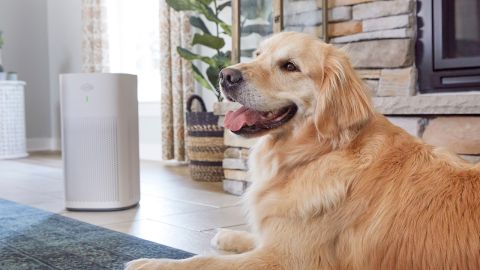
Among the gasses emitted by everyday liquids and solids around your home, volatile organic compounds (VOCs) are a particular concern. Typically You can’t see them, but you can often smell them when you use hairspray, paint your home, install a new carpet, paint your fingernails, or use cleaning agents and pesticides. These VOCs may cause eye, nose and throat irritation, headaches, nausea or dizziness. Health effects can also include liver, kidney or nervous system damage, as well as memory impairment.
While viruses are a concern nowadays, the EPA is keen to point out that an air purifier alone is not enough to protect you from COVID-19. In fact, there’s no magic bullet to remove all the nasty contaminants from the air we breathe every day — but numerous studies in the NIH Library of Medicine show that an air purifier can be part of your strategy against infection and does make a difference when combined with other interventions like masks.
An air purifier can also cut down on dust settling on your stuff, which means you have less chance of noxious things settling around your house where you are likely to disturb it and inhale it later. As Nicole Backus, product manager at Hamilton Beach explains, “air circulation in general is key… if [the air] is stagnant and you don’t have any movement in the air, gasses and dust are going to settle on hard surfaces. You’re going to pick them up and you’re going to pick up a lot more.”
When it comes to purifying the air in your room, an air purifier needs to do two things. It needs a means of removing harmful particles and gasses — typically done by a set of filters, as well as the ability to circulate most of the air in the room through those filters multiple times per hour using a fan. You’ll want to choose a device that does both of those jobs well.
The EPA recommends that all the air in your room be processed through your air purifier five times per hour (you’ll see this listed in specs as air changes per hour). To help you determine if a given air purifier will work for your room, most manufacturers list a maximum or recommended room size and some will even mention how many air exchanges for the space per hour.
That’s a good guideline, but we recommend you also look for CADR (Clean Air Delivery Rate) ratings for smoke, dust and pollen. CADR ratings are better because they’re independent of room size. The CADR number tells you how quickly the air purifier removes 100 percent of a given pollutant – like smoke, dust, or pollen – from a cubic foot of air per minute. The higher the rating, the larger the space an air purifier can clean or the more times per hour it can change the air.
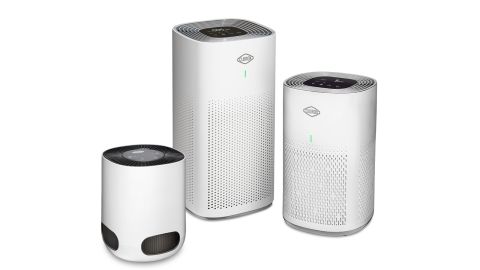
To be sure you’re finding the right air purifier for your space, the best thing to do is to calculate your room’s square footage by multiplying its width and length, then look for a CADR rating that is about two-thirds of that number. With the EPA’s recommendation of five air changes per hour, that means a minimum CADR rating of 65 for a 100 square foot room (with 8-foot ceilings) and a minimum CADR rating of 390 for a 600 square foot room (with 8-foot ceilings). If the air purifier you’re interested in doesn’t display a CADR rating or the “AHAM Verified” logo, you can also check AHAM’s database of CADR certified air purifiers, which lets you easily search by room size, brand and CADR rating.
Although it may seem logical to just buy the largest air purifier with the highest CADR rating, “the bigger the better isn’t the way it works,” says Jill Notini, Vice President, Communications & Marketing for AHAM. “If you overtreat, it will be too loud.” And that may lead to turning it off. Ideally, your air purifier should be sized so it runs at a low level or frequently cycles on and off to keep the air circulating — which should keep noise to a minimum.
Right now CADR ratings describe general performance on all pollutants. But since exactly what gets pulled out of the air at what rate does matter, AHAM has just released CADR testing standards for microbiological and VOCs, so starting in 2023, you can expect to see CADR ratings for microbiologicals (an m-CADR rating) and VOCs (a c-CADR rating) on purifiers, which may help in selecting units for specific needs.
To clean air, all high-quality portable home air purifiers use filters — in fact, you should only be purchasing an air purifier that uses filters to clean the air. That’s because the other available methods you may see — using ultraviolet light, ionization, and so forth — aren’t regulated and in most cases aren’t even suitable for home use.
The main line of defense in an air purifier is a HEPA (high efficiency particulate air) filter, the gold standard for air purifiers used in the US. HEPA filters are made from a dense tangle of very fine fibers, which trap particles — smoke, dust and pollen, for example — as air passes through them (it’s more or less the same technology used in N95 masks, commercially available respirators, and air conditioner and furnace filters). A variety of US and international standards are used when referring to HEPA filters, so you’ll find mentions of HEPA filters, graded 10-17 according to the European standard, which are graded in terms of their efficiency.
You’ll sometimes see the term “true HEPA” used; that’s a marketing term used to differentiate filters that meet EPA’s HEPA standard. This requires the removal of at least 99.97 percent of particles larger than or equal to 0.3 microns in diameter and is different than “HEPA-type” or “HEPA-style” filters which may share a similar construction method but don’t meet the standard and are likely not as effective — though they do tend to be less expensive.
There are, however, many airborne contaminants much smaller than 0.3 microns; the most concerning are viruses and the smallest particulate emissions of vehicles, furnaces and industry. The US HEPA standard doesn’t specifically address particles smaller than 0.3 microns across (the filters were developed in the 1940s to deal with airborne radioactive contaminants of that size) or “ultrafine” particles smaller than 0.1 microns across.
However, you don’t necessarily need a filter specifically meant to remove ultrafine particles to get rid of these microbiologicals or nanoparticulate contaminants. Consider that N95 masks are still the standard for combating transmission of the Covid-19 virus, and they use a similar technology at even lower efficiency.
These filters work well against particles that are, on paper, below their threshold for a couple of important reasons. First, many of these tiny threats stick together, or end up piggybacking on other, larger particles. “A common misunderstanding,” according to the EPA “is that filters need to remove particles as small as viruses to be effective. Microbiological contaminants (e.g., viruses and bacteria) are not suspended in the air on their own, but on particles that are larger than them and sometimes carry many organisms each. Removing the particles therefore removes the microbiological contaminants.”
Plus, when it comes to those ornery ultrafine particles that may be floating around on their own, HEPA filters may not be precisely designed to capture particles smaller than 0.3 microns in diameter, but it turns out they are pretty capable of doing so in practice. Recent NASA research suggests that HEPA filters are as good or better at catching ultrafine particles as they are at dealing with their intended targets; testing done by KCL (Korea Conformity Laboratories) and FITI bears this out (and you’ll see it cited in the literature distributed along with Coway air purifiers). In the end, HEPA filters can be effective in capturing viruses — which is why the CDC and EPA recommend their use against viruses in homes and other confined spaces, even if they aren’t a guaranteed or complete solution to the transmission of illnesses such as Covid-19.
While HEPA filters are in fact more effective than advertised against very small particulate threats to health, it may be important to remember that HEPA and HEPA-style filters don’t remove gasses. Thus many, but not all, air purifiers also have an activated carbon filter to remove odors and toxic gasses such as VOCs. If you live in an area with wildfires, are trying to address an odor issue, or are renovating your home and worried about paint fumes, it’s worth springing for an activated carbon filter. However, it’s not essential if your primary concern is allergies, bacteria, and viruses.
You may see air purifiers that combine air filters with other technologies like ultraviolet light and negative ion generators (ionizers). These products tend to be more expensive, and the technologies don’t have universal testing standards, so it’s hard to compare them. Also, the EPA has concerns that some ionizers “may generate ozone, directly or indirectly, unless specifically designed and certified not to (e.g., devices with the UL 2998 certification).” The problem with this is that ozone is itself a “highly toxic gas even at low concentrations.” So it’s best to avoid such devices.
Since air purifiers should run regularly, if not all the time, you’ll definitely want to choose a model that keeps energy use to a minimum. According to the EPA, a standard room air purifier uses 450 kWh per year, which is more than some new refrigerators. Energy Star rated air purifiers need to be over 25 percent more efficient than standard models. On the EPA site, you can compare air purifier models by room size, CADR for smoke, CADR for pollen and CADR for dust.
The best place to put an air purifier is the middle of the room. Of course, that’s not practical or even possible in most cases. At a minimum, you should leave a foot between the air purifier and the wall or large furniture. Carolyn Lee, Coway Senior Brand Marketing Manager, says, “the ideal placement of an air purifier takes into consideration where in the home is most exposed to harmful particulates, such as smoke or pet hair, while considering airflow from a window or door. By having the air purifier in a high airflow area, you allow the unit to pick up denser pollutants that have enough air energy behind them to carry them from one place to another.”
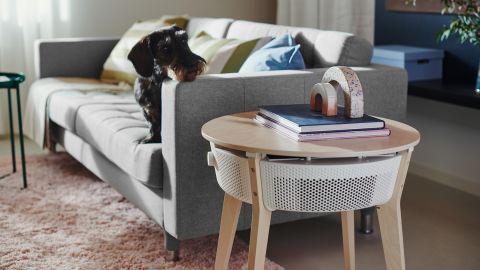
Because air purifiers are large and you’re not supposed to hide them in a corner, aesthetics are important. To help with this conundrum, some air purifiers, like the Ikea Starkvind (recommended for up to 215 sq ft) and Coway Airmega Icon (recommended for 649 sq ft), are designed to look like furniture, and the Samsung Bespoke Cube (recommended for 350 sq ft) has interchangeable front panels like the rest of Samsung’s Bespoke appliance lineup so you can change up the look.
Because air purifiers don’t remove all harmful gasses, it’s important they don’t build up inside. So, it’s a good idea to open your windows to ventilate your home when outdoor air quality is acceptable (check Accuweather and Weather Underground for daily ratings) — and make sure to remember to turn off the air purifier. This will help save your filters, which won’t be able to keep up. If you’ve purchased the right-sized air purifier for your room, all the air will be filtered within 20 minutes of closing the window and turning the air purifier back on.
HEPA filters usually need replacement every year, while activated carbon filters are typically full after six months. “No matter how expensive your air purifier is, it won’t purify the air well if you don’t manage the filters properly,” notes Carolyn Lee, Coway Senior Brand Marketing Manager.
Some manufacturers’ filters are washable. However, you still have to replace the filters, just not as frequently. And the washable filters are more expensive, often costing the same as replaceable filters over time. Failing to replace the filter will reduce the efficacy for HEPA filters and VOC filters will stop working when they are full.
Many air purifiers have filter reminder lights that come on to tell you when to change your filters and some have apps that will not only remind you to change the filter, but will also order replacement filters for you.
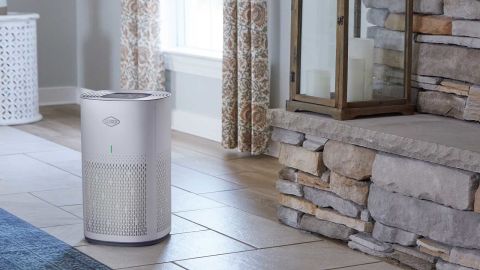
Some air purifiers, especially those that cater to pet owners, have a pre-filter to catch pet hair before air reaches the finer HEPA and activated carbon filters. For instance Samsung’s Bespoke Cube air purifier has a Pet Mesh filter ($59.00). This saves the life of the more expensive filter in the unit and prevents it from becoming clogged. These filters can be vacuumed or wiped down and reused.
Most air purifiers built for medium to large spaces have an air quality monitor built-in, which provides visual feedback – usually a red, yellow, green, or blue light – and automatically adjusts the speed of the fan in the air purifier to maintain optimal air quality. You’ll find this even on inexpensive models, like the Clorox Medium Room Air Purifier ($159.99, recommended for 225 sq ft).
The air-quality sensor also helps save energy by running the fan only as needed. Some air purifiers can also be controlled via an app, show you air quality data, and let you know when you need to change your filters. For instance, the Samsung Bespoke Cube works with the SmartThings app and will let you see your air quality, turn the Cube on and off, and order filters.
Before you invest in an air purifier, check on the following to make sure you have the best experience (and minimize your energy costs too):
1. Measure your room size to find the square footage.
2. Your air purifier will, at minimum, need a HEPA filter. Use your room size to find out the appropriate CADR minimum rating. You will find separate ratings for smoke (the smallest particles), dust (medium size particles) and pollen (the largest particles).
3. Determine what types of filters you need. While you will get the best results from a purifier that uses a pre-filter, a HEPA filter and an activated carbon filter, you can potentially save money if you don’t need an activated carbon filter or pre-filter. A pre-filter is essential for larger pollutants like pet hair, and extends the life of your HEPA filter, and an activated carbon filter is essential for gases, VOCs, odors, and the like. If you’re doing renovations or live in an area where wildfire smoke is a big concern, spring for the activated carbon stage — you’ll be happy you did.
4. Check the type of filter used. We recommend sticking with a HEPA filter that removes at least 99.97 percent of particles larger than or equal to 0.3 microns in diameter.
5. Look for the Energy Star logo to ensure the air purifier is not an energy hog.
6. Check the decibel rating for the fan speeds. Air purifiers should operate below 30 decibels at the lowest fan speed so you can run them while you sleep. Also check the noise level at the highest speed. This is the speed at which the CADR rating is measured and will be the most efficient at cleaning the air. If your air quality is expected to be poor for an extended period of time, like with wildfires, the high fan speed sound level will be especially important. Anything over 50 decibels will make conversation difficult.
7. Check to ensure there is some type of mode that will turn on the air purifier periodically to keep the air in a room circulating. It could be on a schedule or based on a built-in air quality sensor.






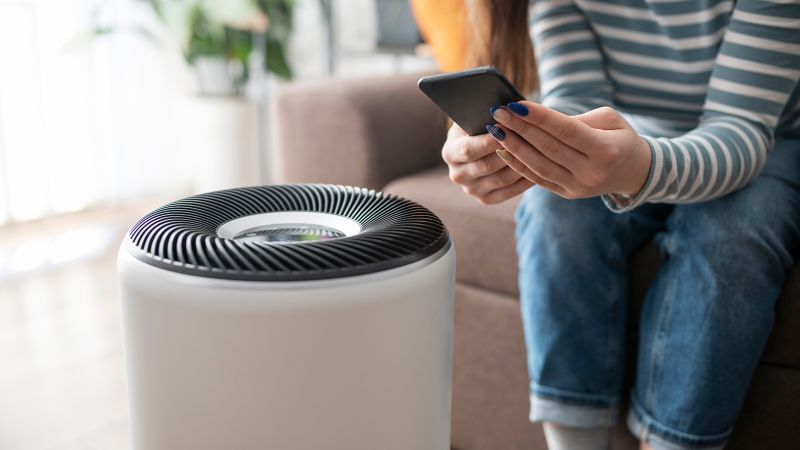
More News
E.P.A. Severely Limits Pollution From Coal Burning Power Plants
Supreme Court to Hear Trump Immunity Case, and Campus Protests Spread
The Crackdown on Student Protesters